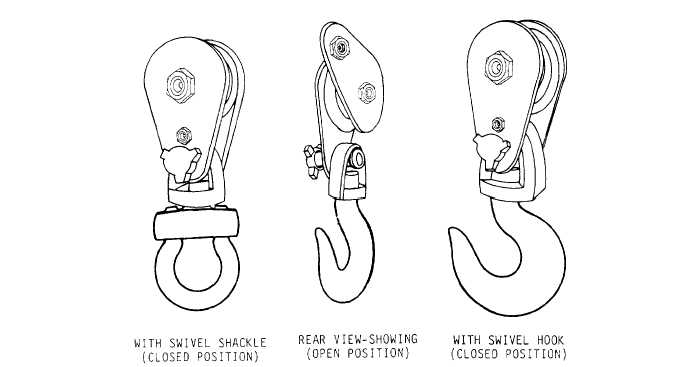line. However, an inch or so either way doesn't matter too much; for example, a 3-inch line may be reeved onto an 8-inch block with no ill effects. As a rule, you are more likely to know the block size than the sheave diameter. However, the sheave diameter should be about twice the size of the circumference of the line used.
Wire rope manufacturers issue tables that give the proper sheave diameters used with the various types and sizes of wire rope they manufacture. In the absence of these, a rough rule of thumb is that the sheave diameter should be about 20 times the diameter of the wire. Remember that with wire rope, it is diameter rather than circumference that is important. Also, remember that this rule refers to the diameter of the sheave rather than to the size of the block.
SNATCH BLOCKS AND FAIRLEADS
A snatch block (figure 4-22) is a single-sheave block made so that the shell opens on one side at the base of the hook to permit a rope or line to be slipped over a sheave without threading the end of it through the block. Snatch blocks ordinarily are used where it is necessary to change the direction of the pull on a line.
Figure 4-23 shows a system of moving a heavy object horizontally away from the power source using snatch blocks. This is an ideal way to move objects in limited spaces. Note that the weight is pulled by a single luff tackle, which has a mechanical advantage of 3 (mechanical advantage is discussed below). Adding snatch blocks to a rigging changes the direction of pull, but the mechanical advantage is not affected. It is, therefore, wise to select the proper rigging system to be used based upon the weight of the object and the type and capacity of the power that is available.
The snatch block that is used as the last block in the direction of pull to the power source is called the leading block. This block can be placed in any convenient location provided it is within 20 drum widths of the power source. This is required because the fairlead angle, or fleet angle, cannot exceed 2° from the center line of the drum; therefore, the 20-drum width distance from the power source to the leading block will assure the fairlead angle. If the fairlead angle is not maintained, the line could jump the sheave of the leading block and cause the line on the reel to jump a riding turn.

Figure 4-22. - Top dead end snatch blocks.
Continue Reading